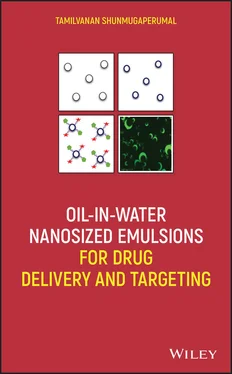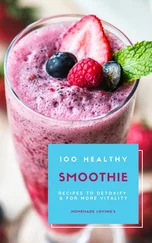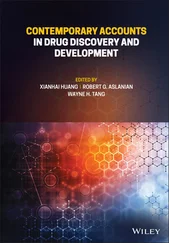Chapter 6starts with a narrative on how the emulsion surfaces can possibly be decorated with different functional molecules for the purpose of extracting a multifunctional activity in a single drug delivery and drug targeting system. Various medical applications of emulsions achieved/obtained through different administration routes are discussed in detail in this chapter.
Chapter 7intends to provide an overview of some selected and miscellaneous uses of nanosized emulsions to interface with the recent application.
Chapter 8describes the various steps ranging from laboratory level manufacturing together with safety aspects evaluation in animal and human eyes to industrial scaleup and then successful commercialization of cyclosporin A‐loaded nanosized emulsions. Other case study included in this chapter is fish oil‐based emulsions.
With these collective information, this book serves as a guide for emulsion formulation developers working in academic environment and at the industrial level.
Tamilvanan Shunmugaperumal
CHAPTER 1 INTRODUCTION: AN OVERVIEW OF NANOSIZED EMULSIONS
TAMILVANAN SHUNMUGAPERUMAL
Department of Pharmaceutics, National Institute of Pharmaceutical Education and Research (NIPER), Guwahati, Assam, India
1 1.1. Introduction 1.1.1. Nanotechnology: Definition 1.1.2. Nanosized emulsions
2 1.2. Conclusion References
EXPANSION OF ABBREVIATIONS
APIactive pharmaceutical ingredientsBCSbiopharmaceutics classification systemDCSdevelopability classification systemGSEgeneral solubility equationLSWLifshitz and Slezov and Wagner theoryMSmetastableNPsnanoparticlesO/Woil‐in‐waterTmmelting pointUSFDAUnited States Food and Drug Administration W/Owater‐in‐oil
Inadequacy is the term that influences in every corner of modern scientific world. Starting from clothes, food, water, and shelter for covering the basic needs of living to affordable medicines for managing any ailments, the inadequacy plays major roles to judge the standard living of every country in the world. In the present scenario of democratic countries like India, USA, etc., the political party which acquires the adequate number of parliamentary members either elected by highest number of people votes in the constituency or after election shuffling with opposite party, is able to form the government for ruling the country another 3 or 5 years. Here too the adequacy means a lot to form the government and the inadequacy leads the party to sit opposite to ruling party. Coming to the affordable medicines, the presence of adequate amount of active pharmaceutical ingredient (API) in a dosage form becomes the prime importance to elicit the desired and often required pharmacological activity following administration of the same into human body. But achieving the adequate amount of API in the particular dosage form requires a lot of formulation knowledge input. How to manufacture the dosage form with adequate amount of API? The answer to this query primarily depends on solubility of API followed by its permeability, molecular size, therapeutic index, etc. If the water solubility of API is low, then, the enhancement of API’s solubility becomes a major concern in pharmaceutical industries for converting the inadequate API aqueous solubility amount into adequate category. This type of converting the API amount from inadequate to adequate category needs the tremendous supports from formulation scientist who has the experience to solve this concern. The lucrative way adapted routinely in the pharmaceutical industry for deleting the word inadequate from the API aqueous solubility is just to combine the API with a suitable nanosized API delivery system or just to pulverize or micronize the API into nano‐level size ranges. This book accentuates the use of one of the nanosized API delivery system to erase the inadequate aqueous solubility from API. Before proceeding with the nanosized API delivery system, a brief history of nanotechnology is being described below.
1.1.1. Nanotechnology: Definition
Pulverized API having nanometer size ranged particles and intact API‐loaded nanoparticles (either preformed or forming in situ ) are considered one of the most‐prevalent improvement methods which have been used to overcome the problem of API's poor solubility and, thus, bioavailability, as well as to achieve targeted API delivery. Having said the importance of pulverized API as nanoparticles (NPs) or API‐entrapped nanoparticulate system, there is no single definition of what a NP is. This might be because of the highly multidisciplinary nature of nanotechnology. The term “nanotechnology” was first used by Norio Taniguchi in 1974, at the University of Tokyo, Japan, for any material in the nanometer size range (Taniguchi 1974) and the materials somehow handled by human beings in their everyday life. According to the United States Food and Drug Administration (USFDA), materials are classified as being in the nanoscale range if they have at least one dimension at the size range of approximately 1–100 nm. However, the characteristic properties of nanoscale such as solubility, light scattering and surface effects are predictable and even these properties are indeed continuous characteristics of the bulk materials (Donaldson and Poland 2013), the definitions of “nanomaterial” based on size are often inconsistent and the upper end of the nanoscale at 100 nm is an arbitrary cut‐off (Boverhof et al. 2015). Thus, the 100‐nm limit is often considered constraining and, according to a more‐inclusive definition, particles <1,000 nm in each dimension (submicron particles) is designated as NPs (Keck and Müller 2006). The latter more‐inclusive definition is particularly applicable in the pharmaceutical field since the particle size in the nanometer range can lead to increased dissolution rates because of the increase in surface area and increased saturation solubility (Junghanns and Müller 2008). In this respect, the generation of nanometer range particles from the API molecule itself is coming under NPs with a nomenclature of API nanocrystals or API nanosuspensions. On the other hand, encapsulating the API into a preformed or in situ forming nanosized API delivery carrier is also grouped under NPs. Now the question will arise, at an industrial environment, which type of API is going for API nanocrystals/nanosuspensions formation and which type of API needs to go as cargo in a nanosized carrier? To clarify this confusion, the following discussion is devoted wherein the poorly soluble API is grouped into two categories.
1.1.1.1. Poorly Water‐Soluble Grease Ball and Brick Dust Molecules
It is now well known that the poor API solubility is an issue for approximately 70–90% of new APIs (Merisko‐Liversidge and Liversidge 2011; Müller and Keck 2012). According to Lipinski (2005) there are two different classes are available within the poorly soluble APIs viz. (i) grease ball and (ii) brick dust molecules.
Hydrophobic APIs have a limited capacity to interact with the water phase, in accordance with “ similia similibus solvuntur ” (like dissolves like), and these APIs are solubility‐limited by poor hydration. The poorly soluble APIs restricted in solubility by poor hydration are described in the popular scientific jargon as “grease ball” molecules, due to their high hydrophobicity and lack of interaction with water. Although they possess poor water solubility (insolubility is probably due to the salvation extreme), the grease ball molecules are easily soluble to lipids or oils and therefore these molecules can plausibly be formulated into lipid‐or oil‐based formulations. In contrast, the brick dust molecules are poorly soluble due to crystal packing interactions being insoluble to both aqueous solvents and lipids or oils. So, the aqueous solubility of brick dust molecules could be enhanced by the formation of amorphous materials or particle size decrease, e.g., nanocrystallization. Thus, formulating APIs as nanocrystals should be mainly used as a solubility enhancement formulation approach to brick dust molecules rather than to grease balls.
Читать дальше












